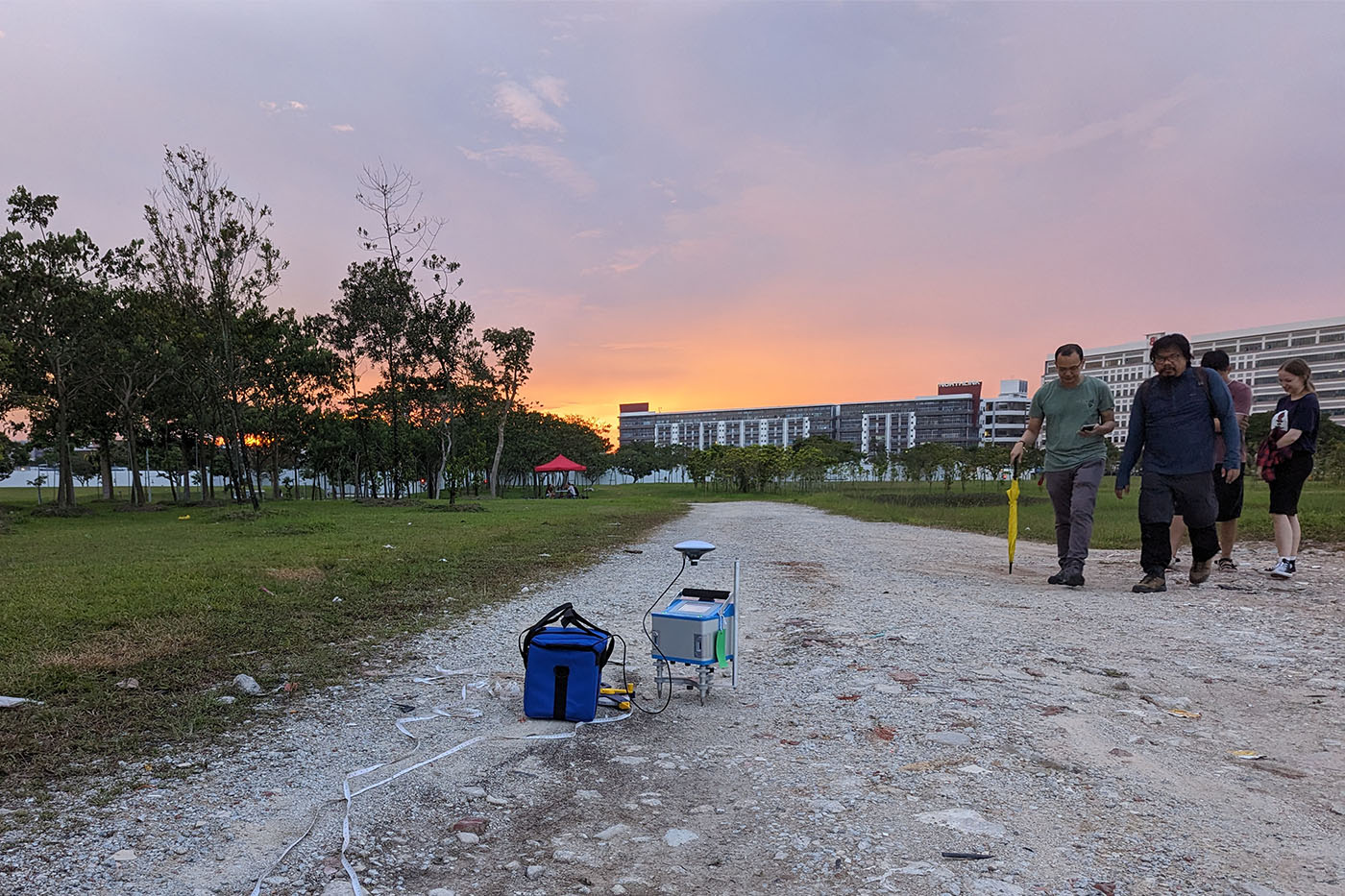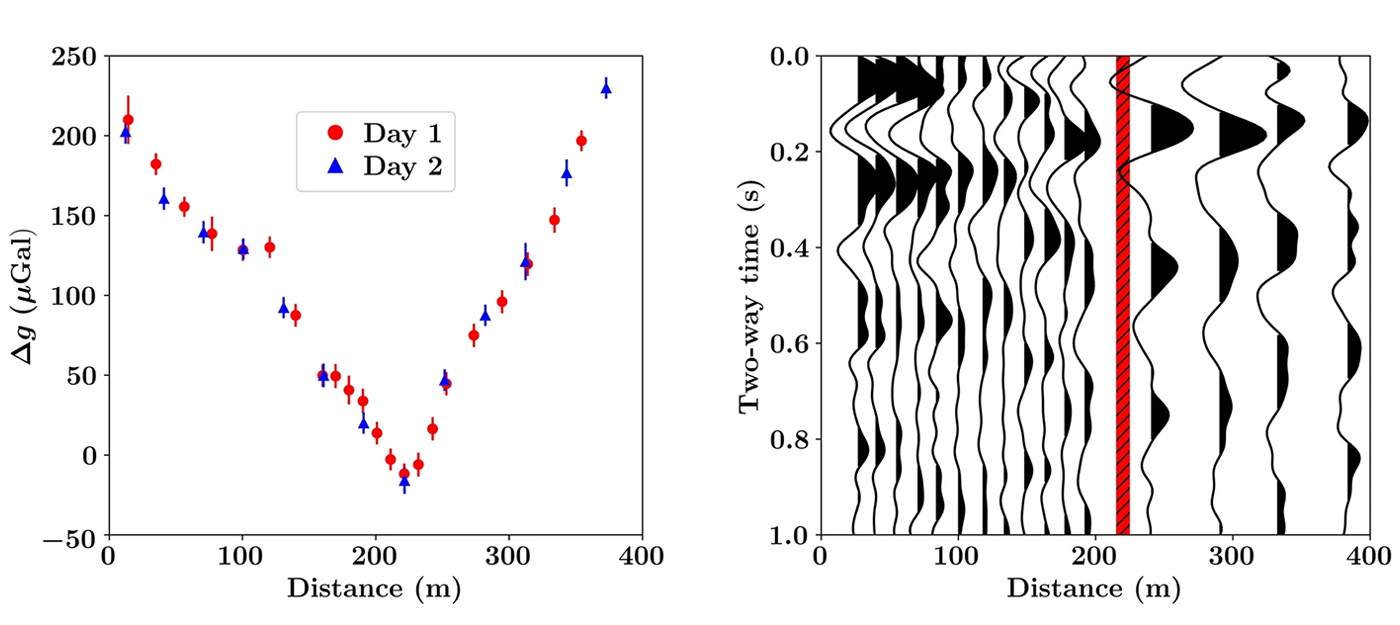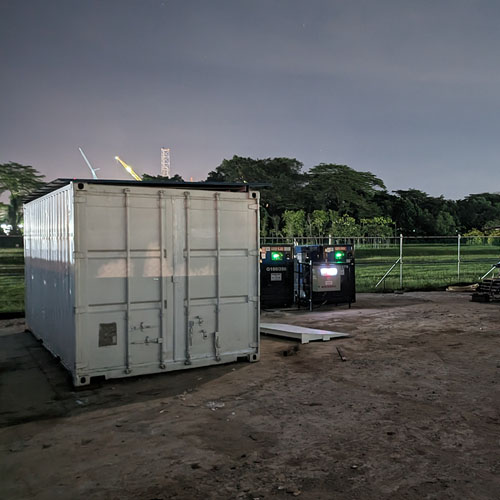Highlights
Portable atomic gravimeter shows promise in the field
 Researchers from the Earth Observatory Singapore and CQT with the classical gravimeter at the survey site in May 2023.
Researchers from the Earth Observatory Singapore and CQT with the classical gravimeter at the survey site in May 2023.
Atomic quantum gravimeters are a promising tool for geophysics, but challenging to bring out of the laboratory. CQT Principal Investigator Rainer Dumke’s group have managed it, using their atomic gravimeter to help detect a gravity anomaly in a field in Singapore.
The group published their results in Scientific Reports on 18 March 2024. Rainer’s co-authors are current and former group members Nathan Shettell, Lee Kai Sheng, Oon Fong En, Elizaveta Maksimova and Christoph Hufnagel, and Associate Professor Wei Shengji, a Principal Investigator at the Earth Observatory of Singapore (EOS).
Monitoring changes in gravity can give insight into geophysical processes such as groundwater movement, geothermal activity, volcanic activity and glacier ablation.
The site Rainer’s team surveyed is being assessed as a potential location for geothermal power generation. In July 2023, a different team of researchers had found that the site could have temperatures of about 200 degrees Celsius at depths of four to five kilometres and deeper. This makes the site promising as a geothermal resource.
The survey was carried out across a potential fault zone structure, which is a discontinuity in the rock masses in the Earth’s crust. This structure could act as a pathway for water to travel from the underground geothermal reservoir to the surface. A discontinuity in the rock masses would be expected to show up as a decrease in gravity.
An absolute reference point
An atomic gravimeter accurately infers gravity from a free-falling cloud of atoms in a vacuum chamber. As it makes use of the wave-like properties of matter, an atomic gravimeter is ‚Äėdrift free‚Äô. This means that the gravity measurements are stable over time and not affected by changes in temperature or changes in the device's mechanical or electronic components, unlike classical gravimeters.
Precision up to micro-Gal sensitivity, or 10-9 of the standard value of gravity, and long-term stability make the atomic gravimeter ideal as an absolute reference point. Classical gravimeters are also precise but have the problem of drifting. Absolute measurements make it possible to compare gravitational data taken at different sites or dates, mitigating ambiguity in the data from the drift of classical gravimeters.
Rainer’s team built their atomic gravimeter to be about 75 cm square, 200 cm tall and 300 kg heavy. It was installed at the site in a shipping container.
Over the course of the survey in May 2023, while the atomic gravimeter collected data at a static position, the researchers used a smaller classical gravimeter to collect data from the surrounding area. They performed measurements that were approximately 25 m apart along a path parallel to a nearby road. To sustain the accuracy of the classical gravimeter, it was calibrated and recalibrated periodically against the atomic gravimeter.
 CQT Principal Investigator Rainer Dumke showing the raw data collected during the survey.
CQT Principal Investigator Rainer Dumke showing the raw data collected during the survey.
In their post-processing of the data, the team determined the drift rate to calibrate six measurements. The calibrated measurements were then mapped to an absolute measurement by the atomic gravimeter. The researchers could do this with an effective precision of 7.7 micro-Gal. ‚ÄúThis level of precision is necessary to accurately monitor the expansion of geothermal reservoirs with gravity measurements,‚ÄĚ write the researchers in their paper.
Gravity anomaly
The results from the team’s survey show a gravity anomaly, a sharp dip of approximately 250 micro-Gal, about 230 metres from the container. This suggests the presence of a subterranean anomaly. The location is consistent with data derived from a separately conducted seismology survey at the site. The classical gravimeters on their own could reveal this anomaly, but adding the stable absolute reference would allow close monitoring over long time periods.
 The left panel plots the horizontal gravity gradient from the gravity geophysical survey. The dip shows a gravity anomaly about 230 metres in proximity to the atomic gravimeter. The right panel plots the seismic reflectivity from the seismology survey where the gravitational minimum is indicated by the red bar. Image credit: Sci Rep 14, 6511 (2024).
The left panel plots the horizontal gravity gradient from the gravity geophysical survey. The dip shows a gravity anomaly about 230 metres in proximity to the atomic gravimeter. The right panel plots the seismic reflectivity from the seismology survey where the gravitational minimum is indicated by the red bar. Image credit: Sci Rep 14, 6511 (2024).
‚ÄúOur gravity survey delineates the precision and effectiveness of utilizing an on-site atomic gravimeter alongside classical compact gravimeters during geophysical surveys,‚ÄĚ write the researchers in their paper. ‚ÄúThis hybridization is especially effective in monitoring slowly varying time-dependent signals, as observed in spatially and temporally resolved groundwater monitoring or the progressive melting of polar ice caps.‚ÄĚ
Building on what they have learned in their survey expedition, the researchers are already working on a second-generation gravimeter that is more compact and robust. A long term goal is to swap the free-falling atoms for a 'guided interferometer' configuration that could be more easily miniaturised.
Learn more
Related Stories
 | Quantum gravimeter helps check what lies underground July 26 2023 |
 | CQT researchers awarded grants under Singapore’s Quantum Engineering Programme April 21 2022 |






